Thick descriptions
Pandasia and China’s Panda Diplomacy
By Marrit Meinema.
Infected by the hype surrounding Pandasia on the park’s website, the new panda enclosure in Ouwehands Zoo, Karlijn and I rushed past the giraffes, lions and mandrills to see the park’s main event of the day: breakfast with Xing Ya and Wu Wen, the giant pandas. Making our way to the panda enclosure, we stumbled upon an enormous Chinese pagoda. Even the sign-post contained Mandarin signs followed by Dutch translation. Quite alarmed by this stereotypical display of Chinese culture, Karlijn and I walked to the inside area of the panda enclosure. Numerous people were swarming at the windows of the inside enclosure. To get the best view, children were jumping up and down and trying to squeeze through the crowds. Peering through the window of the enclosure on the right side of the pagoda, I saw one of the pandas, Wu Wen, almost lifelessly lying on a tree branch, with her limbs hanging at the sides of her body. What struck me was that Wu Wen was alone – the female panda Wu Wen and male panda Xing Ya were kept in separate parts, unable to visit each other. Then the breakfast event began and we made our way to the outside enclosure again.
For the breakfast event only Xing Ya was let outside after an employee spread different kinds of vegetables and bamboo across the outside enclosure. The aim of this distribution of food is that the panda has to search for the food. While Xing Ya entered the outside enclosure, the employee answered the question that had been stuck in my mind – why the animals were separated: the reason for their separation was the solitary nature of the giant panda. If they were to put the pandas together now, the chances of them producing offspring during mating season would get slimmer and baby pandas are high on the list of priorities for the zoo. Meanwhile an enormous crowd equipped with smartphones and cameras had formed around the enclosure, from the walls surrounding the enclosure to the balcony of the pagoda, taking every opportunity to photograph the cuddly panda along the wooden path. This included Karlijn and me of course.
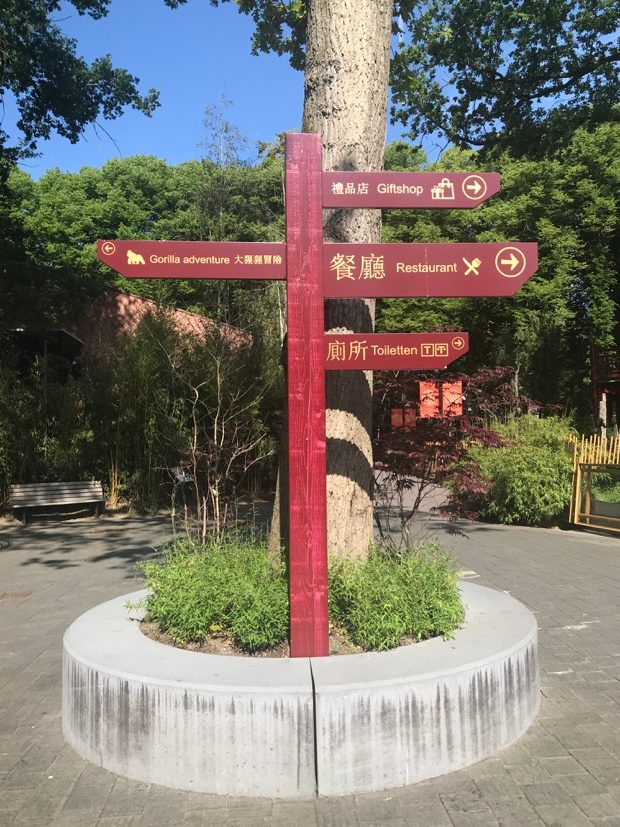
Signpost near Entrance Pandasia.
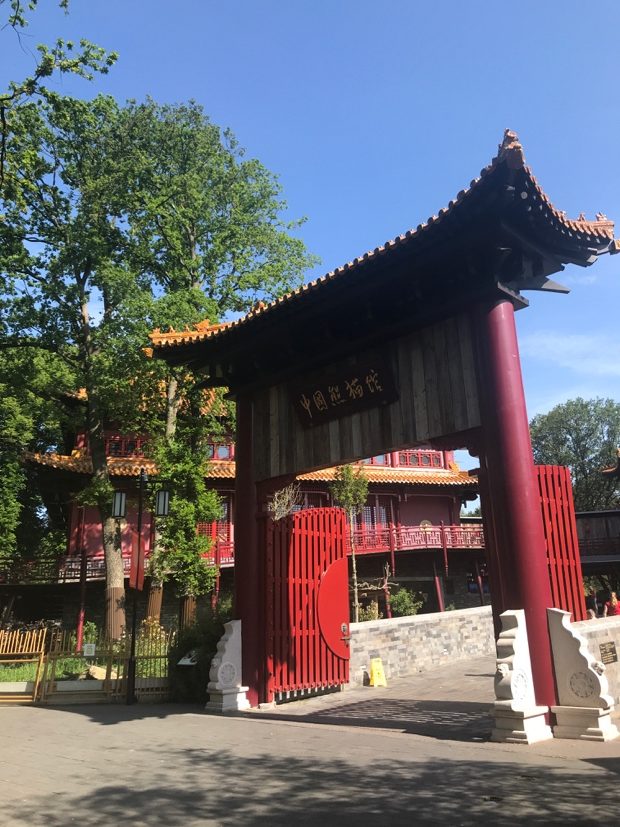
Entrance gate to Pandasia Pagoda.
The caretaker informed the audience about the diet and eating habits of the giant pandas. Or rather, the eating habits and diet they impose on the pandas. She told the people that the zoo gives the pandas their meals at the regular times that humans eat: breakfast, lunch and dinner. Nevertheless, she affirmed that naturally the pandas can choose not to eat if they are not hungry, yet the food will always be served at set times. The diet of the pandas consists mostly of bamboo but they will also regularly give them panda cake which is full of calcium and protein, one slice amounting to 4.000 kilocalories! Meanwhile Xing Ya had found his bamboo and moved behind the covered wooden platform which was irritating to the woman standing beside me. Agitated, she complained to who we assumed to be her boyfriend, “now those boards are blocking my sight, I can’t see anything”. Karlijn and I exchanged a glance and decided to walk around the pagoda.
The next thing we encountered was the panda giftshop that was filled to the brim with panda merchandise. From mugs to panda onesies, from big stuffed animals to umbrellas, purses, hats, anything you can put a cute panda face on, they have it. In the shop, a television screen that hangs at the center of the shelves stacked with stuffed animal pandas tells us that “with the purchase of a WWF stuffed animal panda you support the collective giant panda project of the WWF and Ouwehands Zoo in Sichuan, China”. This excessive amount of merchandise, the prominent advertisement of Pandasia on the website, and the cultural embellished building of the panda enclosure, in comparison to the lack of these things for the other animals made apparent for me the importance of the pandas’ presence at the zoo. Therefore, for my thick description of the panda enclosure at Ouwehands zoo, I want to find out what the political/diplomatic phenomenon is that lies behind the arrival of the giant pandas at Ouwehands Zoo.
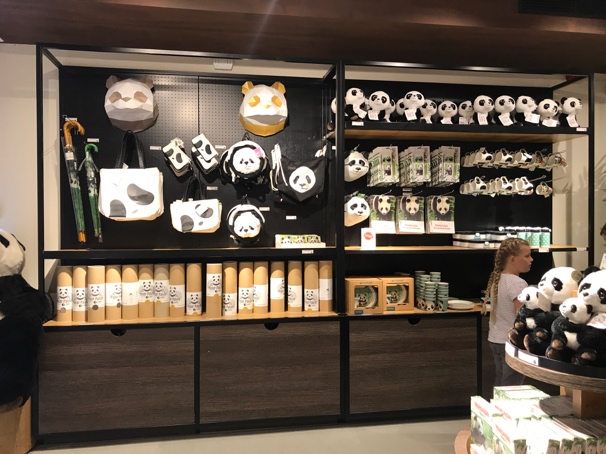
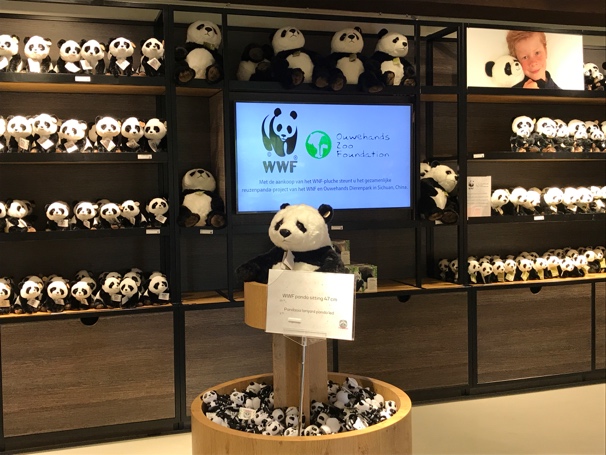
Panda-Diplomacy
Falk Hartig describes public diplomacy simply as “the instrument to activate [a country’s] soft power” (51). Put in more detail, it aims to attract the public abroad and to dismantle “negative clichés and prejudices, generate sympathy and understanding for [a] nation’s ideals, goals, (foreign) policies, its institutions, culture and model of society, to build a positive image and relationships” (Nye qt. in Hartig 51). The public diplomacy of a specific country can thus increase a foreign public’s familiarity with this country and its appreciation of this country, and in the best possible scenario, leads a foreign public to engage with them and might even influence the foreign public in a favorable way for this country (51). The goal of Chinese public diplomacy is thus to make the world familiar with China and help foreign publics to understand the real China.
It is far from a secret that the giant panda has been, and still is, one of the most important diplomatic tools for China. Panda diplomacy has come from a long tradition of animal diplomacy in general, as animals were used by rulers to please and coax foreign rulers, also having a lasting effect on the public (Hartig 53). Since the seventh century, Rosemary-Claire Collard claims, panda diplomacy has been used by China to establish good relations with other countries, it is symbolic of “China’s warm feelings toward foreign powers” (227). As Hartig states, some analysts of China’s public diplomacy view the panda as a vital part of China’s soft power, because no foreign country would be able to resist the adorableness of the pandas, particularly the youth, thereby winning favor for China (50). If I may compare this to the number of people present for the breakfast of Xing Ya in Ouwehands Zoo, I can safely say that this is very true.
Even though no changes are made with regard to the policies of foreign countries towards China who receive a panda, Hartig states that “the symbolic gesture of donating these animals to selected countries should not be underestimated” (51). Hartig is interested in the economic aspect of panda which I will also examine with regards to the Netherlands, and another aspect which becomes clear: “namely China’s ability to integrate international partners in its public diplomacy activities and make them pay for its attempts to shape China’s global image” (51). Hartig claims that panda-diplomacy helps to achieve the general aims of public diplomacy, “such as reducing negative clichés and prejudices, and generating sympathy and understanding by creating and presenting a good image of the country” (52).
Hartig mentions that there are two basic requirements and two guiding principles for a successful execution of animal diplomacy. The first basic requirement is the visual identity of the animal, the level of success of the animal diplomacy depends on the appeal of the animal (55). Due to Konrad Lorenz’s Kindchenschema from 1943, it is well known that humans find childlike characteristics appealing because these stimuli “evoke a care and protective instinct as well as the feeling of cuteness” (Hartig 55). Therefore, the animals that carry these characteristics such as kittens, puppies and pandas are most appealing to us. The visual identity of the animal, in this case the giant panda, is important to attract both the attention of zoogoers as well as the media. In the Netherlands, the arrival of Xing Ya and Wu Wen drew the eye of many different news platforms as I will later discuss in more detail.
Secondly, the natural distribution of the animal is important. Animal diplomacy becomes more successful when the animal is only found in the donor country because this means that the animal is exclusively associated with this country. Fortunately for China, the giant panda is only found in specific mountain areas in the West of the country, making the animal synonymous with China and seen as its national icon. Animal symbolism can go as far as to express the national character, but, as Hartig states, it is debatable “whether China is as peaceful and friendly as the panda may suggest” (58). Nevertheless, the message that the panda as symbol for China transmits is also indisputable.
Lastly, the two guiding principles of presentation to the public and the method of distribution are important. As for the presentation to the public, it is the responsibility of the zoo as an institution to present the pandas to the public. However, the method of distribution has changed over time. In earlier periods, pandas were presented as gifts to foreign powers, however, with Chinese conservation programs and international conservation treaties, the animals are now only given away on loan (58). Not only does this entail that foreign countries pay large amounts of money to host these animals, Hartig explains, but this also means that foreign countries are actually paying for one of their most important diplomatic tools (58). Moreover, the extensive media coverage about the pandas puts China, even if only temporarily, in a good light because these reports almost exclusively forget to bring up the negative aspects of the country.
According to Buckingham, Jepson and David, workings of panda loans in the past indicate that China approaches the animals beside commercial transactions also “as an avenue to signal forms of disapproval in bilateral relations” (5). For example, after the meeting between Barack Obama and the Dalai Lama, – China had warned the US that this would damage their bond – the two panda cubs were back on a plane to China two days after these warnings. This risk for repatriation of a beloved city panda could thus also work as a form of punishment, thereby directly affecting the city in question.
The giant pandas have proven to be a useful diplomatic tool for China to familiarize foreign publics with their country and introduce the ‘real’ China to dismantle any negative clichés or prejudices a foreign public might have of the country. Since the 12th of April 2017 the Dutch public is also subject to China’s panda diplomacy and the country became infected with the panda craze. In the next section, I will discuss the economic consequences this has for the Netherlands and how panda-diplomacy has taken its form in our country and in Ouwehands Zoo.
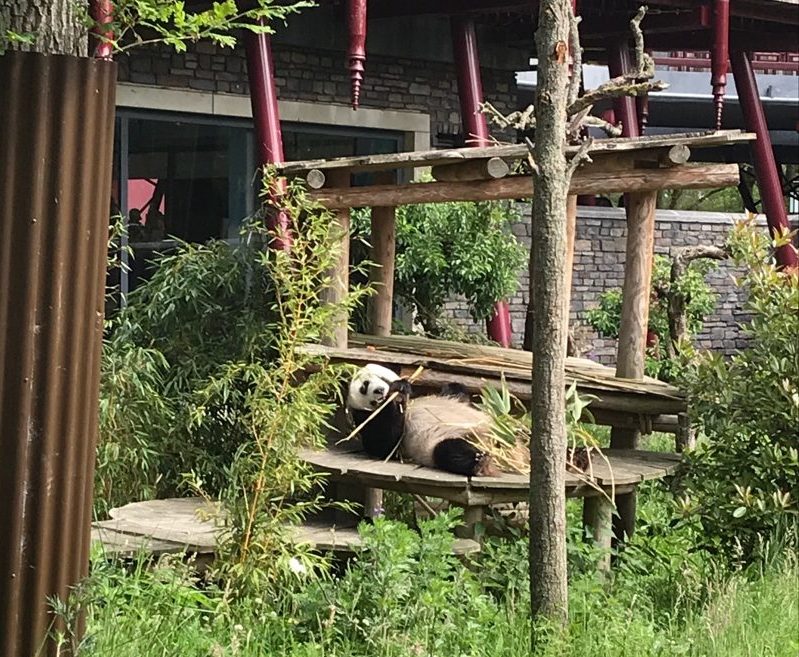
Xing Ya enjoying his breakfast.
Panda-Diplomacy in the Netherlands
With the arrival of Wu Wen and Xing Ya in the Netherlands, China is expanding its inner circle, allowing the Dutch to be the next foreign public to engage with their nation. But how does panda-diplomacy work in the Netherlands and what future plans made China decide to entrust these giant pandas to the Dutch zoo? According to Kathleen Buckingham, Paul Jepson, and Jonathan David, sharing the care for such a precious animal as the giant panda symbolizes, from a Chinese perspective, a “seal” of approval (or “panda of approval”) and intent for a long, prosperous working relationship” (4). As far as the impact of the panda loan as a symbolic acceptance of the Netherlands to the inner circle of China, minister of Developmental Cooperation, Bert Koenders, now retired, called it an incredible honor for the Netherlands to receive these giant pandas because, he claimed, China does not allow many members of the endangered species to leave the country (trans. from “Dit Is Waarom China Panda’s Uitdeelt” NOS). Naturally, this is not true, as I explained in the previous section that panda-diplomacy has been part of China’s soft-power for a long time now, but it does show the impact of China’s symbolic gesture on the receiving country. The feeling of trust that comes with China’s gesture of lending two giant pandas, an endangered species, has a great political effect on the receiving countries, strengthening the friendship between the two political forces which is clearly already working in the Netherlands. Secondly, the arrival of the pandas on the 12th of April in 2017 caused a great stir in the Dutch, but also the international public as it was extensively covered by Dutch as well as international media platforms. A live video report by RTV Utrecht, “Aankomst Wu Wen En Xing Ya Op Schiphol,” shows how the pandas were flown over in a private airplane with the images of the two panda faces on the cockpit and accompanied at Schiphol by numerous police cars to ensure their safety. In what seems like a high school gymnasium, a huge event attended by over 120 journalists was set up to welcome Wu Wen and Xing Ya. At 1:48:30 a cargo vehicle is seen pulling the two cages containing the two pandas into the room and the pandas are received with applause. This extensive media coverage did not end after their arrival, as Dutch newspapers and other media outlets continue to keep an eye on them in the months following.
Moreover, in terms of China’s political gains of its loan of the panda pair to the Netherlands, Victor van Dooren argues in an article by Annabelle de Bruijn for the Algemeen Dagblad this move is of great strategic significance for the donor country: “The Netherlands are of strategic importance for China. The harbor of Rotterdam is an important logistic link in China’s future plans. In addition to this, the Dutch possess essential knowledge about food safety, a field in which the Chinese themselves are struggling, and forestry” (my trans.). Although, as Hartig also states, no policies are changed during the signing of the panda loan contracts, we can safely assume that these points are a big part of why China has decided to lend the Netherlands these pandas.
In addition to the strategic importance of the Netherlands for China, Ouwehands Zoo is also paying for China’s diplomatic tool. Annually Ouwehands, and specifically Pandasia, has to earn back 1 million euros that the park has to “donate” to China in order to keep the pandas here. The term donation is a bit ambiguous here as it implies that the Netherlands are paying this amount on a voluntary basis, which is of course not the case. Additionally, the money is supposed to be devoted to the conservation projects in China, however, researchers have found no published data to back up this claim (Hartig 62). Moreover, according to de Bruijn, the zoo invested more than seven million euros in the enclosure of Wu Wen and Xing Ya. Beside this, the costs for the food and care of pandas are high: solely the costs for bamboo already amount to half a million per year.
In a podcast from EenVandaag, Harm van Atteveld interviews zoo director Robin de Lange and talks about how the zoo is able to afford the costs that come with the panda loan. De Lange claims that thus far Pandasia has been a great success. Several factors have influenced this outcome, this includes the increased revenues of the Chinese/Asian restaurant and the incredible sales of the panda merchandise. Especially the panda onesies and the panda-printed baby clothes are very popular, says de Lange. In addition to this, the turnover rate of the zoo doubled because of the possibility to set up business meetings and other events at the panda enclosure. De Lange is very pleased with this because the pandas have become one of the most important sources of funding for the new Bonobo enclosure that is currently being built at Ouwehands.
Lastly, Pandasia seems to fulfill the aim of public diplomacy and that is, familiarizing the Dutch public with China and its culture. By embellishing the panda enclosure in the style of a traditional Chinese temple, the zoo seems to enhance and spread the image of China. At least, if we believe the Ouwehands Zoo website: “To make it authentic, the design includes various Chinese elements, ornaments and accessories. … The roof and wall structures were made in China using traditional methods, and have been finished in suitable, authentic colours. The walls feature round elements with Chinese depictions. The roof is covered with traditional tiles that were handmade in China according to traditional methods. The shape, structure, proportions, materials and colours of the buildings are all based on a Chinese temple. … A restaurant with a Chinese/Asian ambiance … will also be a part of the project” (my emphasis).
Being the only animal enclosure with such prominent cultural imagery in the entire zoo, it seems clear that the pandas are a way to stimulate the global image of China within the Dutch public. Therefore, considering what I have argued thus far, it seems that China has found in the Netherlands yet another successful implementation of its panda diplomacy.
The Future of the Giant Panda
Clearly both parties benefit from the panda loan to Ouwehands Zoo: China by earning a large amount of money and having an external party paying for the promotion of Chinese culture, and the Netherlands by gaining an important political partner. Yet what about the giant pandas Wu Wen and Xing Ya themselves? What do they gain from their migration to the Netherlands? As the animals clearly mean nothing more than a political commodity, a national symbol, their suffering and individual lives as animals are once again dismissed in favor of, as Collard argues, “the project of capital accumulation and economic growth” (230). The spectacle made from the panda’s arrival, their breakfast as main event of the day in the zoo and the extent of the panda merchandise in the giftshop only confirms this.
In terms of conservation of the panda population in the wild, the zoo does contribute, as its joint project with the WWF in Sichuan, China, is financed in part by the sales of the plush pandas in the zoo’s giftshop. Moreover, the zoo’s intention to breed the pandas is also working to stimulate the panda population. However, after the first unsuccessful attempt to have the two pandas mate – Xing Ya being only interested in playing with Wu Wen – the employees of Ouwehands still have their work cut our for them. Additionally, despite these efforts to stimulate the panda population, another problem for the conservation of the wild panda is that thus far no successful methods have been found to release captive pandas back into the wild (Buckingham, Jepson & David 5).
Once again, or rather still, the animal is included in our politics through its exclusion, merely working either as a universal symbol for global conservation (seeing that the WWF/WNF’s avatar is also a giant panda) or as a national symbol for China, thereby making it almost impossible to separate the species from politics (Buckingham, Jepson & David 7). Consequently, this also affects the future of the panda in the wild: “As pandas become more visible in global zoos, boundaries between wild and captive will blur” (5-6). We can thus only hope that China invests the foreign ‘donations’ it receives for the loaning of their pandas into the conservation of the species. Although this thick description has also been mostly concerned with the political effects of the panda-diplomacy, this paves the way for future research to search for ways to separate the giant panda from politics. Otherwise, if we continue to ignore the panda as a diplomatic tool, the captive giant pandas might outlive the ones that we find in the wild.
Works Cited
“Aankomst Wu Wen en Xing Ya op Schiphol [RTV Utrecht].” YouTube, RTV Utrecht, 12 Apr. 2017, www.youtube.com/watch?v=9VvjLWGkdJA.
Atteveld, van, Harm. “Panda’s Ouwehands Dierenpark kosten miljoenen; dit leverden ze al op.” EenVandaag, 6 Apr. 2018, eenvandaag.avrotros.nl/item/pandas-ouwehands-dierenpark-kosten-miljoenen-dit-leverden-ze-al-op/.
Bruijn, de, Annebelle. “Zo krijg je een panda van de Chinezen.” Algemeen Dagblad, 30 May 2017, www.ad.nl/utrecht/zo-krijg-je-een-panda-van-de-chinezen~ae2a04c2/.
Buckingham, Kathleen C., Jepson, Paul R., and Jonathan N. W. David. “Diplomats and Refugees: Panda Diplomacy, Soft ‘Cuddly’ Power, and the New Trajectory in Panda Conservation.” Environmental Practice, 2013. 1-9.
Collard, Rosemary-Claire. “Panda Politics.” The Canadian Geographer, vol. 57, no. 2, 2013. 226–232.
“Dit is waarom China panda’s uitdeelt.” NOS, 26 Oct. 2015, nos.nl/op3/artikel/2065246-dit-is-waarom-china-panda-s-uitdeelt.html.
Hartig, Falk. “Panda Diplomacy: The Cutest Part of China’s Public Diplomacy.” The Hague Journal of Diplomacy, vol. 8, 2013. 49-78.
“Pandasia.” Ouwehands Dierenpark, https://www.ouwehand.nl/en/discover/pandasia
“Vijf vragen over de panda’s Wu Wen en Xing Ya.” NOS, 12 Apr. 2017, nos.nl/artikel/2167808-vijf-vragen-over-de-panda-s-wu-wen-en-xing-ya.html.

